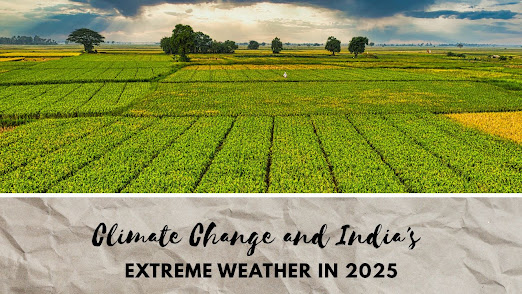India’s battle with climate change intensified in 2025, with extreme weather events becoming more frequent and severe. From deadly heatwaves to catastrophic floods, the country faced unprecedented challenges. This article examines the key weather events, their impacts, and India’s response to the growing climate crisis.
Unrelenting Heatwaves Scorch Northern India
Northern India endured record-breaking heatwaves in April and May 2025. Temperatures soared above 48°C in Delhi and Rajasthan. Prolonged heat disrupted daily life, forcing schools and businesses to shut. Over 2,000 heatstroke deaths were reported nationwide.
The urban heat island effect worsened conditions in cities. Lack of green spaces and concrete dominance trapped heat. Power demand surged, leading to frequent blackouts. Vulnerable populations, including laborers and the homeless, suffered the most.
Deadly Floods Submerge Mumbai and Kerala
In July 2025, Mumbai received a month’s rainfall in just 48 hours. Floodwaters submerged homes, roads, and railways, paralyzing the city. Over 300,000 people were displaced, and rescue operations lasted weeks.
Kerala faced similar devastation as heavy rains triggered landslides. Entire villages were washed away, killing hundreds. Poor urban planning and deforestation worsened flood impacts. Experts linked these events to warming Indian Ocean temperatures.
Cyclones Batter Eastern Coastal States
Cyclone Biparjoy-2 struck Odisha and West Bengal in July 2025. Wind speeds exceeded 180 km/h, destroying homes and farmlands. Storm surges flooded coastal regions, displacing millions.
Fishing communities suffered huge losses. Crops like rice and sugarcane were ruined, raising food prices. While early warnings saved lives, infrastructure damage cost billions. Rising sea levels made coastal areas more vulnerable.
Agriculture and Food Security Under Threat
Erratic monsoons disrupted India’s farming cycle in 2025. Delayed rains hurt kharif crop sowing, while unseasonal downpours damaged harvests. Wheat yields dropped by 15% due to extreme heat.
Farmers faced rising debts as crops failed. Food inflation hit a 10-year high, straining household budgets. Experts warned of long-term threats to India’s food security if climate trends continue.
India’s Shift to Renewable Energy
India accelerated solar and wind energy projects in 2025. Rajasthan and Gujarat became solar power hubs, reducing coal dependence. However, fossil fuels still dominated energy production.
The government launched new green policies, including carbon trading schemes. But slow implementation and funding gaps hindered progress. Clean energy adoption remained uneven across states.
Adaptation and Mitigation Strategies
To combat extreme weather, India invested in climate-resilient infrastructure. Cities like Chennai expanded drainage systems to handle floods. Heat action plans provided cooling shelters and public awareness campaigns.
Farmers adopted drought-resistant crops and precision irrigation. Coastal regions built stronger embankments to resist cyclones. Yet, experts stressed the need for faster, larger-scale adaptation measures.
Global Cooperation and Future Challenges
India pushed for stronger global climate commitments in 2025. It demanded richer nations fund climate adaptation in vulnerable countries. However, international negotiations moved slowly.
Without urgent action, India could face even worse disasters by 2030. Reducing emissions, protecting ecosystems, and upgrading infrastructure are critical. The time to act is now—before the crisis deepens.
Conclusion
2025 was a wake-up call for India on climate change. Extreme weather events disrupted lives, economies, and ecosystems. While adaptation efforts are underway, faster policy action is essential. The world must unite to cut emissions and support vulnerable nations. India’s future depends on resilience, innovation, and global solidarity.






No comments:
Post a Comment
Edit your Comment